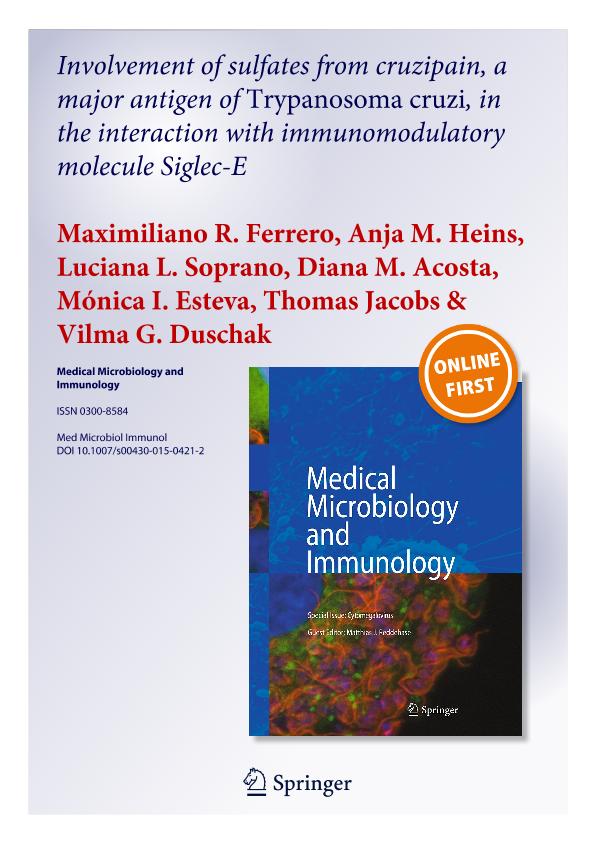Artículo
Involvement of sulfates from cruzipain, a major antigen of Trypanosoma cruzi, in the interaction with immunomodulatory molecule Siglec-E
Ferrero, Maximiliano Ruben ; Heins, Anja M.; Soprano, Luciana Lía
; Heins, Anja M.; Soprano, Luciana Lía ; Acosta, Diana Maria
; Acosta, Diana Maria ; Esteva, Mónica Inés; Jacobs, Thomas; Duschak, Vilma Gladys
; Esteva, Mónica Inés; Jacobs, Thomas; Duschak, Vilma Gladys
 ; Heins, Anja M.; Soprano, Luciana Lía
; Heins, Anja M.; Soprano, Luciana Lía ; Acosta, Diana Maria
; Acosta, Diana Maria ; Esteva, Mónica Inés; Jacobs, Thomas; Duschak, Vilma Gladys
; Esteva, Mónica Inés; Jacobs, Thomas; Duschak, Vilma Gladys
Fecha de publicación:
06/2015
Editorial:
Springer
Revista:
Medical Microbiology and Immunology
ISSN:
0300-8584
Idioma:
Inglés
Tipo de recurso:
Artículo publicado
Clasificación temática:
Resumen
In order to investigate the involvement of sulfated groups in the Trypanosoma cruzi host–parasite relationship, we studied the interaction between the major cysteine proteinase of T. cruzi, cruzipain (Cz), a sulfate-containing sialylated molecule and the sialic acid-binding immunoglobulin like lectin-E (Siglec-E). To this aim, ELISA, indirect immunofluorescence assays and flow cytometry, using mouse Siglec-E–Fc fusion molecules and glycoproteins of parasites, were performed. Competition assays verified that the lectins, Maackia amurensis II (Mal II) and Siglec-E–Fc, compete for the same binding sites. Taking into account that Mal II binding remains unaltered by sulfation, we established this lectin as sialylation degree control. Proteins of an enriched microsomal fraction showed the highest binding to Siglec-E as compared with those from the other parasite subcellular fractions. ELISA assays and the affinity purification of Cz by a Siglec-E column confirmed the interaction between both molecules. The significant decrease in binding of Siglec-E–Fc to Cz and to its C-terminal domain (C-T) after desulfation of these molecules suggests that sulfates contribute to the interaction between Siglec-E–Fc and these glycoproteins. Competitive ELISA assays confirmed the involvement of sulfated epitopes in the affinity between Siglec-E and Cz, probably modified by natural protein environment. Interestingly, data from flow cytometry of untreated and chlorate-treated parasites suggested that sulfates are not primary receptors, but enhance the binding of Siglec-E to trypomastigotic forms. Altogether, our findings support the notion that sulfate-containing sialylated glycoproteins interact with Siglec-E, an ortholog protein of human Siglec-9, and might modulate the immune response of the host, favoring parasitemia and persistence of the parasite.
Palabras clave:
Trypanosoma Cruzi
,
Cruzipain
,
Sulfates
,
Siglec-E
Archivos asociados
Licencia
Identificadores
Colecciones
Articulos(SEDE CENTRAL)
Articulos de SEDE CENTRAL
Articulos de SEDE CENTRAL
Citación
Ferrero, Maximiliano Ruben; Heins, Anja M.; Soprano, Luciana Lía; Acosta, Diana Maria; Esteva, Mónica Inés; et al.; Involvement of sulfates from cruzipain, a major antigen of Trypanosoma cruzi, in the interaction with immunomodulatory molecule Siglec-E; Springer; Medical Microbiology and Immunology; 205; 1; 6-2015; 21-35
Compartir
Altmétricas



